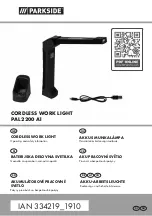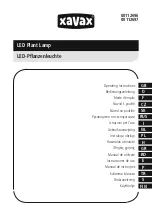
Latest products and information available at www.sealite.com
14
SL-PEL Series
Sectored Port Entry Light
ALIGNMENT OF THE PEL SECTOR LIGHT:
While there is no best single method of achieving a commissioned alignment, there are many variants on
how alignment may be achieved. The PEL sector light is an accurate instrument but it should be noted
that the centre line of the beam is theoretical, and the only points of accurate reference are the edges of
the total beam (light cut off) or between colours. It is these reference lines which should be used to set up
the light and these bearing lines should be drawn on the chart and bearings noted.
Option 1 (Preferred method)
Refer to the chart and select known defined points on land at a distance of approximately 1/2 to 3/4 of
a mile from the sectored light. This may be the edge of a quay or rock with established beacon which is
identifiable on the chart from which a distance to one of the bearing lines can be measured by tape over
land. This point can be determined prior to the installation and marked by a wooden peg or spray painted
spot on a rock or quay wall.
Option 2
If such a point is not available over land, the same can be achieved using a measure line of
Polypropylene floating rope which can be laid out from a small boat and held in tension in a given
direction previously determined from the chart.
Option 3
If none of the bearing lines make land fall or the distance from land is greater than 100 to 200 metres
then the operation of alignment must be conducted dynamically by boat with reference to a Theodolite
alignment. Method 3 will require the Theodolite to be set up at the base of the tower directly below the
light on the centre line of the theoretical bearing or on the balcony of the tower itself. It must be on the
centre line of the approach with reference to all other local marks.
Clear Line of Sight
The position selected must have a clear line of sight of the bearing lines on the day of alignment and not
be obstructed by any vessel.
Time of Alignment
The best time to align the light is when light levels are at their softest (early morning or dusk). Viewing the
light in the direction of a rising and setting sun should be avoided and a time selected where the tide suits
those marks which have been selected for reference. This is important in areas with high tidal ranges,
both for access to the mark and draft of the vessel (if used to get to the location).
Personnel required
At the reference point:
One competent observer with VHF radio or mobile phone who can communicate in the same language
as the commissioning technician without the need of a translator.















































